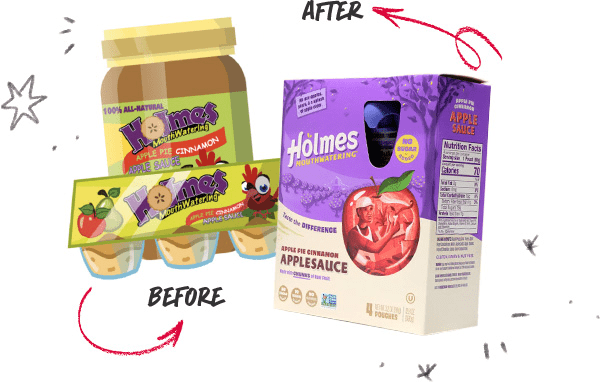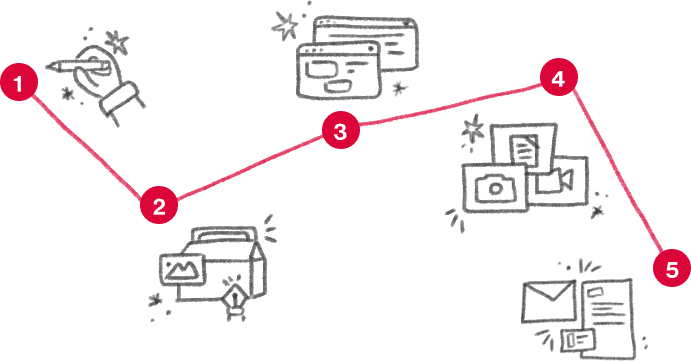From the daily agenda to long-term goals, checklists are invaluable for navigating simple and complex processes. When transforming your existing brand into a new, dynamic identity, our comprehensive company rebranding checklist is the ultimate guide, ensuring you cover your bases and set yourself up for a successful transition.
Determine your rebranding why.
When engaging in a rebranding initiative, anticipation creates excitement, causing the fundamental question of “Why rebranding?” to be overlooked. Yet, understanding the reasons for rebranding is a critical first step. It shapes every other decision in the rebranding launch checklist, directs the brand strategy, and ensures all team members recognize the reason for the change.
A sample of potential reasons for rebranding may include:
Outdated brand identity.
Creating a new brand identity can bring new life to a forgotten brand.
Shift in company structure and mission.
Bringing brand awareness to a new set of values and purpose.
Market changes.
Adapting to consumer expectations, emerging trends, and preferences for the target audience.
Global expansion.
Scaling your brand to international markets and serving a global audience.
Mergers and acquisitions.
Harmonizing multiple brand identities into one.
In nearly every situation, there will be multiple reasons for rebranding, so don’t feel obligated to choose a single one; instead, focus on the top three reasons.
Is it the right time for rebranding?
Before having a clear rebranding roadmap, companies must decide whether it’s the right time to implement changes. Even with a handful of reasons, it may be the wrong time to begin the rebranding process. A vital box to tick on the rebrand checklist is confirming that you have enough time, resources, and capital to create new company branding.
In some cases, deferring to the next quarter may be a better idea as you clear through the current brand’s inventory, inform partnerships about the upcoming brand identity change, and allocate enough money and staff for the initiative’s duration.
Establish your rebranding budget and brand implementation roadmap.
As a rebranding agency, an issue we experience with start-ups and brands in desperation is diving headfirst into rebranding without fully considering the costs. A well-defined budget ensures you do not cut corners or run out of fuel to complete the process. A prepared budget creates a roadmap for efficiently allocating resources; with a margin of safety, be prepared for the unknown.
Consider the following factors when creating your rebranding budget.
01
Strategy Costs:
The fees for acquiring outside expertise, including consultants and company rebrand checklist specialists.
02
Research Costs:
All expenses related to market data and communications with the target market in surveys and panel interviews.
03
Design Costs:
This includes expenses for redesigning all visual elements, such as logos, color schemes, and packaging. These costs vary significantly depending on whether you opt for in-house designers or a high-profile design agency.
04
Testing Fees:
All brand testing, including design and message testing, to confirm the best strategy to push forward.
05
Marketing Expenses:
Effectively launching your rebrand demands a comprehensive marketing strategy, which means budgeting for social media campaigns, PR, and an event or product launch.
06
Legal Fees:
Rebranding often involves new trademarks or revisiting existing contracts, which incur legal costs. These are especially important if you’re making a significant change, like renaming the company.
07
Miscellaneous Expenses:
These may include changing signage and business stationery to updating software and digital platforms to reflect the new brand.

Create your rebranding team for asset rebranding.
Delegating the rebranding process to a single individual is a recipe for mediocrity and missed outcomes. Diverse internal and external team members are needed to create the best strategy, refined and optimized for penetrating the target market. Here’s a look at potential candidates for your rebranding effort.
Internal team members.
Brand Manager:
Fully understands the intricacies of the brand and the environments in which the product is presented.
Marketing Director:
Provides valuable insights into distinct brand messaging and competitor’s positioning.
Design Department:
Able to bring ideas to the table on best presenting visuals and messaging into a cohesive look that stands out.
Key Stakeholders:
Can clarify the timeline, budget, and other executive understandings.
External partners for brand implementation checklist.
Branding Agencies:
Experts in strategic messaging and design for peak performance with the target audience.
Legal Advisors:
Ensure the rebrand adheres to intellectual property laws, contracts, and regulatory compliance.
PR Firms:
Manage public image and communication, orchestrating a seamless transition to the new brand identity.

Perform extensive research.
Now that you’ve assembled a team, it’s time to begin the research phase for your brand refresh checklist. This process resembles branding a new company, with the added dimension of factoring in your existing branding’s role in shaping the future direction of the rebranding process. And this is where our research begins.

Brand research.
Nearly every company structure carries some brand equity, some worth carrying over into the checklist for rebranding. The research process includes reviewing all brand collateral, marketing materials, customer conversations, and social listening to understand how consumers fully see and feel the brand and what they believe about it. Brand research also includes surveys or consumer panels created to understand the brand’s current visual identity and voice.

Competitor research.
One of the biggest mistakes a brand makes during its brand rollout checklist is not performing competitor research. Through competitor analysis, you can find gaps permitting distinct brand positioning that can penetrate a particular category. In a competitor audit, you will employ some of the same tactics as brand research, perform retail audits, and acquire existing market research on the competition nearest to your products.

Trend research.
Understanding the most recent trends guides you in deciding what messages to present when putting together your rebrand checklist and how to articulate them in a way that resonates with existing customers and new audiences you hope to target. With trend research, we want to understand how best to integrate one or more into your particular category for maximum impact on purchase intent.

Channel research.
Each sales and marketing channel will have a unique design, layout, and competitive set. Channel research identifies ways to rebrand yourself with distinct visual appeal to target audiences frequenting these platforms or environments. For example, a nutritional supplement company selling in Costco may need to rebrand differently than one in Walgreens. While your branding cannot align with every channel’s best interest, it’s best to consider your most important channel partners in your rebranding strategy.
Choose your form of rebranding.
With a complete understanding of the brand, competitors, and channels, it’s time to decide how intensive the rebranding process will be. In this situation, we have two main options; a third is a misunderstood component of rebranding.
Partial rebrand.
The first choice is the Partial Rebrand, a strategic option that allows preserving certain brand elements while infusing fresh elements to revitalize the overall identity.
Full rebrand.
The second is the Full Rebrand. On this transformative path, every facet of the brand is overhauled, from visual elements to core messaging, crafting an entirely new and invigorated identity that resonates with the target audience.

Rebrand vs. Brand Refresh
When researching the types of rebrands, you may come across the term brand refresh. This term refers to a more subtle approach to redesigning a brand, but it isn’t enough to qualify as a partial rebrand. A brand refresh alone doesn’t change brand positioning or how to approach the target audience.
Perform further research.
Research isn’t a one-and-done aspect of this brand strategy. Consumer research occurs at various points in the rebranding process as new questions present themselves at each point. Continuing to research is how you get the best possible outcome for your rebrand.
Create rebranding strategies.
With all of the preliminary steps behind us, it’s time for the fun part: creating a set of potential rebranding strategies. Once we understand the target audience’s interests and current brand perception, we can let our creative juices flow for copywriting and design.

Brand Messaging
Every rebrand strategy will lead to messaging that articulates the essence of your brand’s evolution. Your messaging strategy brings the brand story to the forefront, narrating the journey from your origins to your present aspirations. The goal is to create a cohesive narrative you articulate through everything from packaging to website design.

Visual Identity
The messaging strategy creates the initial direction for the visual rebrand. Now is the time to flesh out those concepts into distinct brand visuals that convey the emotions you want consumers to feel and understand. Each element must align, from the font to the color choices, to communicate these core brand messages.

Document New Brand Guidelines
Brands must create a visual and content style guide to ensure consistency across the future brand assets they develop. These new brand guidelines will serve the internal team and any agencies you work with, saving significant time in communications and design iterations for outcomes misaligned with the brand theme.
Design your brand assets.
We’ve finally reached the point where you can let the creative juices flow (concerning the style guide) and create each brand asset to create maximum impact.

-
Logo design
While it doesn’t have to be the initial design, creating a new logo can make the remaining design process more accessible. This new logo provides traction on the rebrand and direction for the remaining assets.
-
Packaging design
The most critical aspect of rebranding for consumer brands is creating a product packaging design that resonates with consumers. Unlike other assets, this is the design they will see each time they shop and, once they acquire a customer, whenever they use the product. It has the greatest potential for influencing initial and repeat purchase decisions.
-
website rebranding checklist
Website rebranding is, unfortunately, where things can go astray. Since this asset has multiple layers, it’s easy to let your brand voice and visual representation snowball out of control. And performing damage control will be a much more complicated process than the effort it takes to prevent it in the first place. -
Digital Assets
Maintaining consistency across your digital assets, such as social media profiles, is necessary to create memorability with potential and existing consumers. Every time the target audience sees your presence online, it should reflect what you present on your packaging and website.
-
Other Touchpoints
The best brands can create rebranding consistency across all touchpoints, including email signatures, business cards, social media content, and marketing materials such as signage and displays. It’s important to consider all touchpoints as marketing channels, even if they are incremental; they can attract people to your brand or steer them in another direction.
Rebrand launch strategy.
How you go to market with your rebrand is as vital as the rebrand itself. Whether it’s a partial or complete shift in identity, every company should have a rebrand launch checklist that is given a total effort. Here’s a sample list of potential action items for your rebrand launch campaign based on the categories of having a presentation deck, public relations campaign, and marketing channel distribution initiative.
| Presentation | PR | Distribution |
| Pre-Launch Teasers | Press Release Circulation | Social Media Blitz |
| Media Kit Creation | Influencer Partnerships | Email Campaign |
| Webinar Briefing | Customer Testimonials | Retargeting Ads |
| Internal Alignment | Event/Unveiling | SEO Update |
| Launch Day Deck | FAQs and How-tos | Collaborations and Sponsorships |
| Asset Overhaul | Crisis Communication Plan | Metrics Monitoring |
| Logo Unveiling | Media Interviews | Iterative Feedback |
| Style Guide Distribution | Op-Eds in Industry Publications | Affiliate Partnerships |
| Visual Mockups | Social Media AMAs (Ask Me Anything) | Geo-Targeted Ads |
| Employee Training | Podcast Appearances | Press Kit Distribution |
| Customer Onboarding Updates | News Coverage Monitoring | Landing Page Optimization |
| Post-Launch Survey | Employee Advocacy | Update in Online Directories |
| Follow-up Webinars | Post-launch Public Briefing | Physical Store Signage Update |
Establish reporting metrics.
Establishing reporting metrics is the only way to understand whether it was a successful rebrand or the result of some other brand strategy. Companies of all sizes can leverage free tools such as Google Analytics and Google Trends for reporting. Larger brands with national distribution may need to invest in more robust SaaS solutions.
Here’s a sample of potential metrics your brand will report on.
| KPI Category | KPI Name | Description | Method of Measurement |
| Financial Metrics | Revenue Increase | The growth in sales revenue after the rebrand | % Increase in revenue compared to pre-rebrand period |
| Financial Metrics | Profit Margin | The percentage of revenue that exceeds costs and expenses | Net income / Revenue x 100 |
| Financial Metrics | ROI (Return on Investment) | The effectiveness of the rebranding investment | (Net Profit / Cost of Rebrand) x 100 |
| Sales Metrics | Per Store Sales | The average sales revenue per retail location | Total Sales / Number of Stores |
| Sales Metrics | Average Transaction Value | The average value of each sales transaction | Total Revenue / Number of Transactions |
| Customer Behavior | Repeat Purchases | The number of customers making more than one purchase | Count or % of customers with more than one transaction |
| Customer Behavior | Conversion Rate | Percentage of visitors completing a desired action (e.g., purchasing, signing up, etc.) | (Conversions / Total visitors) x 100 |
| Customer Behavior | Customer Retention Rate | The percentage of customers who continue to buy from you | (Number of returning customers / Total customers) x 100 |
| Customer Behavior | Churn Rate | The percentage of customers who leave your brand for a competitor | (Customers lost / Customers at the start) x 100 |
| Customer Engagement | Net Promoter Score (NPS) | Customer’s willingness to recommend your brand | Survey-based scores ranging from -100 to 100 |
| Operational Metrics | Inventory Turnover | The number of times inventory is sold and replaced | Cost of Goods Sold / Average Inventory Value |
Data-driven brand development that can guarantee sales performance.
If you need a rebrand with performance predictability, we can help. SmashBrand is a brand development agency that researches, designs, and tests all products to ensure peak shelf performance. Book a time to discuss your project with our team.
Subscribe to
Nice Package.
A monthly newsletter that unpacks a critical topic in the FMCG & CPG industry.
Free Resource.

CPG product repositioning guide.
Explore the five undeniable signs your CPG product needs repositioning along with strategies for leveraging consumer insights for a guaranteed market lift.
Learn More About CPG product repositioning guide.